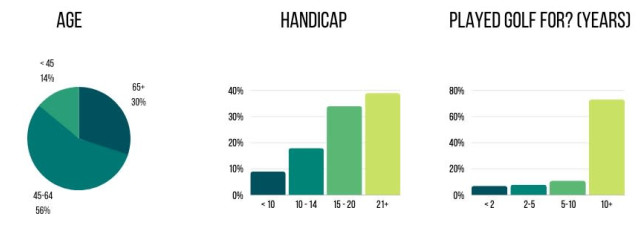
Survey Reveals Attitudes And Barriers to Joining a Golf Club
The wider golf landscape is finally beginning to settle back into something resembling normality following the impact of the pandemic, which ushered in a rapid and unexpected boom in participation but also membership numbers at clubs around the country.
Figures were undeniably impressive during this time and provided a welcome boost to venues and the industry as a whole, but the lingering question of just how things would look in the aftermath was waiting to be answered.
With cost of living pressures remaining and the opportunities presented by lockdowns now (gratefully) a thing of the past, the game has to assess how best it can both retain and recruit members as we move into the heart of a decade that was heavily disrupted at its beginning.
Hoping to gather insights behind the experiences of regular golfers and to potentially shine a light on what we can expect in future, our most recent Golfshake Survey focused solely on the topic of golf club membership and was completed by 4,000 golfers who visited the website during a ten-day period in October/November 2023.
Beginning our analysis of the data that we have assembled, we start by reflecting on those 18% of responding golfers who aren't members of a club but plan to join one during the next year.
This data is similar to the situation back in 2017 when 20% stated they were hoping to join soon.

Are Golf Clubs Doing Enough to Retain Members?
However, most strikingly, 10% of this data also stated that they had stopped their golf club membership in 2023, which raises the subject of just how can golf clubs do more to retain their current members. When it came to reasoning, which is something that we have witnessed frequently, the common factors were; lack of time, membership costs, ensuring value for money, and injury.
These are recurring themes that are unlikely to go away, but a few comments that were submitted highlighted growing issues around membership categories, difficulty with securing tee times, and the challenges faced here in the UK with winter golf.
"So many golfing days were lost to bad weather that it was no longer cost effective to pay an annual membership subscription."
"Cost and lack of use due to injury and poor course conditions due to weather."
"Too expensive for seven months as we don’t play in winter."
"Not prepared to pay £1,350 for an undrained very wet course that is unplayable in the winter months."
"Course too busy in the week, same people hogging tee times. Cheaper to pay and play."
"Membership is too expensive for over 45 years old."
"Too many societies getting booked on weekend."
"Not too many benefits for being a member. Difficult to get a tee time at the weekend and that’s if there was not a comp on."
With many golfers struggling to find value for money with their membership, it's no surprise that many are looking to establishing an alternative relationship with the game, including those who would rather be nomadic and pay as they play.
This isn't a new reality for clubs to navigate - but it's one that has to be considered carefully as the economic environment raises more questions for consumers. Those institutions that innovative quicker may be the ones who ultimately benefit during the years to come.
One of the easiest areas to address is bad communication, which was something that Golfshake's Derek Clements recently encountered during his journey when attempting to join a club in the Norwich area. And he's not alone in being frustrated with that particular department of some establishments.
The survey also found that 50% of the non-club golfers had been members before but surprisingly, of those that had previously been a member, only 23% had been asked to provide a reason why they had left the club.
This does highlight an area that golf clubs should take seriously. It's simply a part of any responsibly managed business, as one golfer noted in a comment that was submitted to us.
"Like any good employer, a golf club should be disappointed to lose a member, and therefore need to solicit feedback to ensure the club hasn't any issues with membership, or anything else."
Retaining members of the future won't be made any easier by not mining the feedback of those who had decided to leave.

What Recruitment Processes Are in Place?
Keeping current members happy and in the building is one thing, but what about recruiting new people into a club? You might be surprised, but 13% of the non-club golfers who responded to us had actually tried to join a golf club in 2023.
Why did they ultimately not join? The main reasons centred around the cost, joining fees and the reintroduction of waiting lists. There were also comments around value for money and impact of winter golf, plus attitudes within some clubs that are still continuing to be mentioned.
"Expense. Unwelcoming atmosphere."
"Price, fees, stand-offish nature of employees."
"Complicated process and snobbery."
"Snobbish and unfriendly members."
"High Joining fees on top of the membership fees."
"Initiation fees + annual dues + food minimum costs = poor value statement."
The process of recruiting members and retaining existing ones should be a marriage, rather than being in contrast and opposition to each other. The most successful golf clubs are the venues that manage to balance the two.
However, it may be the case that this survey data has highlighted tests for clubs, but there are many positives to be taken from the non-club golfers results, especially given that 13% had tried to join a club, 18% planned to join and 50% had been a member at some point previously - underlining that there are potential members out there waiting to be welcomed into a club in the right circumstances.
The challenge for golf clubs is nothing new and just requires the right product offering. Back in 2018, 39% of non-club members said they would join a golf club if there was a flexible membership option that reflected the amount they would play. The latest data would suggest this is still valid and it's a topic we will cover in the next article.
Finally, golf clubs can take further positives from the data. Following the pandemic boom, there are still good signs for clubs with 62% of the non-club respondents stating that they plan to play more golf in 2024, with only 5% planning to play less, meaning that there is further visitor revenue to accrue, if not a rich pond to fish for possible new members.
This will be welcome news for clubs and provides an excellent opportunity to tap into an eager audience with additional green fee revenue or the potential to sell the many benefits of becoming a golf club member. The future is bright if golf clubs are willing to continue to adapt and focus on the future growth opportunities that come with effectively retaining and proactively recruiting members.
Related Content
The Barriers to Become a Golf Club Member
Which Type of Golf Membership Suits You Best
Where Do Golf Club Memberships Stand in 2023
Popular Alternatives to Traditional Golf Club Memberships
What do you think? post your thoughts and feedback on the Golfshake comments: jump to comments here.
Tags: Survey industry insider GOLFERS Golf Memberships Golf Clubs Golf daily picks









